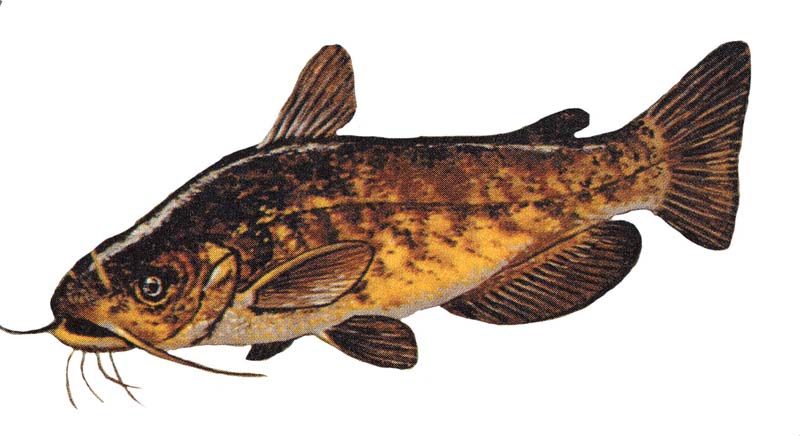- Bullhead catfish
Taxobox
name = Bullhead catfish
fossil_range =Oligocene - Recent

image_width = 240px
image_caption = "Ameiurus nebulosus "
regnum =Animal ia
phylum =Chordata
classis =Actinopterygii
ordo = Siluriformes
familia =Ictaluridae
genus = "Ameiurus"
genus_authority = Rafinesque, 1820
subdivision_ranks = Species
subdivision ="A. brunneus"
"A. catus"
† "A. hazenensis"
† "A. lavetti"
† "A. leidyi"
† "A. macgrewi"
"A. melas"
"A. natalis"
"A. nebulosus"
† "A. pectinatus"
"A. platycephalus"
† "A. reticulatus"
† "A. sawrockensis"
"A. serracanthus"
† "A. vespertinus"
synonyms = "Amiurus" Agassiz, 1846"Gronias" Cope, 1864Bullhead catfish usually refers to the three common types of bullhead catfish found in waters of the
United States , theblack bullhead ("Ameiurus melas"), thebrown bullhead ("Ameiurus nebulosus"), and theyellow bullhead ("Ameiurus natalis"), members of the genus "Ameiurus". They can distinguished fromchannel catfish andblue catfish in that their tailfins are squared, rather than forked. Other fishes of the genus "Ameiurus", such as thewhite catfish ("Ameiurus catus ") have a somewhat forked tail and are not typically called "bullheads", even though they share the same genus.Taxonomy and fossil record
"Ameiurus" is recognized as monophyletic, meaning it forms a natural group. It is mostly closely related to the
clade formed by "Noturus ", "Prietella ", "Satan", and "Pylodictis ".There are seven extant (living) species and eight fossil species of "Ameiurus".cite journal|url=http://silurus.acnatsci.org/ACSI/library/biblios/2007_Ferraris_Catfish_Checklist.pdf|title=Checklist of catfishes, recent and fossil (Osteichthyes: Siluriformes), and catalogue of siluriform primary types|first=Carl J., Jr.|last=Ferraris|journal=
Zootaxa |volume=1418|pages=1–628|year=2007|format=PDF ] The oldest, "Ameiurus pectinatus ", gives a minimum age estimate for the genus at approximately 30 million years, during theOligocene .cite journal|journal=Copeia |year=2003|issue=1|pages=20–33|title=Phylogenetic Relationships among Bullhead Catfishes of the Genus "Ameiurus" (Siluriformes: Ictaluridae)|first=Michael|last=Hardman|coauthors=Page, Lawrence M.]There is a sister group relationship between the species "A. melas" and "A. nebulosus".
Distribution
Living species of "Ameiurus" catfishes are natively distributed east of the
North America n continental divide, from their westernmost point in centralMontana , south toTexas , in streams of theGulf of Mexico andAtlantic Coast, north toNew Brunswick andQuebec ,Manitoba , andSaskatchewan .Habitat
Bullheads live in a variety of habitats, including brackish and/or low oxygen ponds, rivers and lakes, although they are seldom stocked intentionally. They are bottom feeders and eat virtually anything edible, including dead fish, insects, other fish, grain, fruit, crayfish and more. Because of their limited use as food or sport, they are usually caught while trying to catch other fish, and few anglers pursue them specifically. Persons looking to catch bullheads will use the same baits as they would for channel catfish, including cut bait, chicken livers blood soaked meal, or other pungent baits. Like all catfish, bullheads have a sense of smell that is more developed than the best canine. [ [http://www.gameandfishmag.com/fishing/catfish-fishing/gf_aa076502a Understanding Catfish Senses ] ]
Description and identification
Bullheads do not get as large as the other US native catfishes, with averages sizes in the 1 to 2 pound range and world record sizes well under 10 pounds.
All three major bullheads can be confused with other catfishes by novice anglers. Because they have a non-forked tail, many people mistakenly think that small flathead catfish are bullheads. Both have the squared tail, and can have a mottled, brown appearance (in the case of the brown bullhead) but the flathead has a lower lip that protrudes farther than its upper lip and a flat or "shovel" head. They also have very different habits and habitat.
Flatheads generally eat only live things, while bullheads will freely eat dead fish or other small animals. The flathead is more likely to be found at the bottom of dams or in gravel pits, while bullheads are found more often in the most brackish areas. Additionally, flatheads can reach weights well in excess of 100 pounds, while the current world's record for any bullhead is a Black Bullhead, recorded at 8 lb even (3.63 kg), [ [http://fishing.about.com/od/catfish/a/catfishrecords.htm Catfish and Bullheads - How Big is Big - Freshwater Fishing ] ] while the average adult is perhaps 2 pounds. Brown and yellow bullheads are significantly smaller.
Relationship to humans
They are considered
rough fish by many, and are seldom caught for food, although they can be quite edible if caught in clear water and prepared correctly. [ [http://www.wnrmag.com/stories/1998/oct98/brecipe.htm The best 'o bull ] ] In Minnesota, bullhead are important to commercial fishermen, who harvest about 1 million pounds a year. [ [http://www.dnr.state.mn.us/fish/catfish/management.html Catfish Management Minnesota DNR] ]References
External links
* [http://myfwc.com/fishing/Fishes/catfish.html Florida Fish and Wildlife Catfish Description page]
Wikimedia Foundation. 2010.
